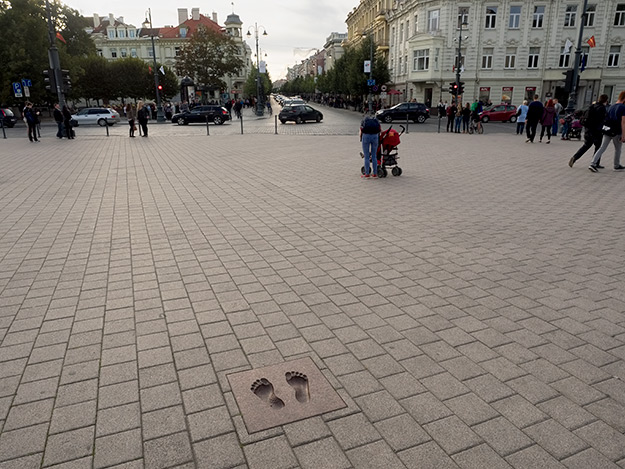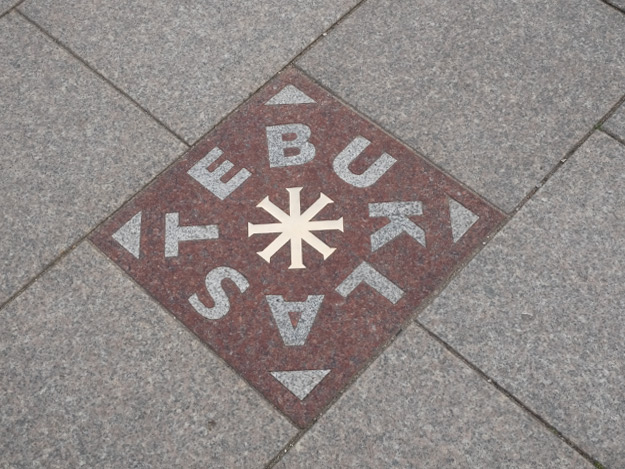Holding hands. It’s a simple act that usually signifies love, friendship, or caring. But on August 23, 1989, the simple act of holding hands freed six million people in the Baltic countries of Lithuania, Latvia, and Estonia.
On that fateful day in 1989, more than two million people joined hands in a human chain that began in Tallinn, Estonia, stretched 430 miles across Latvia, to Vilnius, Lithuania. The date was chosen to focus the world’s attention on the day in 1939, exactly 50 years prior, when Nazi Germany and the Soviet Union signed the Molotov-Ribbentrop Pact. This secret agreement was created during the early years of World War II, when Germany and the Soviet Union were allies. Not only did it pledge non-aggression between the signatories, in a blatant violation of international law, it detailed how Finland, Estonia, Latvia, Lithuania, Poland and Romania would be divided between the two countries. The Baltics were given over to the Soviet Union.

With Russian influence neatly tied up, Germany invaded Poland eight days later, starting World War II. The Soviet Union subsequently invaded Estonia and Latvia on June 16, 1940. Though the Soviets switched to the side of the Allies after Germany attacked them in June of 1941, the Molotov-Ribbentrop Pact essentially remained in effect. The Soviet Union continued to occupy Estonia, Latvia, and Lithuania throughout and following the war, all the while denying the existence of the secret protocols of the Molotov-Ribbentrop Pact.

During the waning years of the Soviet Union, a strong pro-independence movement emerged in the Baltic States, and the idea for the Baltic Way (also known as the Baltic Chain) was born. Exactly 50 years from the date that the Molotov-Ribbentrop Pact was signed, two million people stood shoulder-to-shoulder along highways and in fields, holding hands and singing for their freedom. Their demands were simple: admit the secret protocol of the Pact and restore the independence of Latvia, Lithuania, and Estonia.
Soviet officials were not amused by the Baltic Way. Three days later the Central Committee of the Communist Party issued the following statement: “Matters have gone far. There is a serious threat to the fate of the Baltic peoples. People should know the abyss into which they are being pushed by their nationalistic leaders. Should they achieve their goals, the possible consequences could be catastrophic to these nations. A question could arise as to their very existence.”

Worried that the Soviets might send troops to stamp out dissent, the three countries jointly issued a declaration to the United Nations that they were under threat of aggression and asked that an international commission monitor the situation. Under the scrutiny of the UN, and with pressure to cease and desist coming from the U.S. and Germany, the Soviets did an about-face. On December 24, 1989, they finally acknowledged the secret protocols of the Molotov-Ribbentrop Pact and declared the agreement to have been illegal. Full independence was granted by Moscow to all three countries in August of 1991.
Unfortunately, after the breakup of the Soviet Union, Russia began taking a harder line. Moscow once again insisted that its control of the Baltic States was legal. In 2005, the Kremlin’s European affairs chief, Sergei Yastrzhembsky declared, “There was no occupation. There were agreements at the time with the legitimately elected authorities in the Baltic countries.”
Though such tough sounding rhetoric might seem alarming, residents of the Baltic States seem to feel no threat from their huge neighbor to the east. A large percentage of the tourists who visit the Baltics are Russian, and I heard as much Russian being spoken in the streets as I did Latvian, Lithuanian, or Estonian. Every local person I spoke to about the issue said that Russian aggression was a non-issue.

Today, one of the most visible signs that Baltic citizens will never again bow to aggression lies embedded in the pavements of the three capital cities. In 2013, identical tiles containing the impression of a set of footprints were installed in prominent public locations. In Vilnius, where the idea for the memorial emerged, the tile sits in the center of Cathedral Square. In Riga, the footprints were placed in front of the Freedom Monument. I had to search a bit harder in Tallinn, where the tile has been tucked away in an obscure corner atop a hill in the upper Old Town. Still, the hill overlooks Freedom Square, an appropriately symbolic location.

Interestingly, in Vilnius, where the idea for the commemorative tiles was born, two different tiles have been laid in Cathedral Square. The second is engraved with the word Stebuklas, which translates to “miracle.” It is said that the wish of anyone who stands on the tile and twirls around three times will be granted. When the crowd of tourists cleared, I seized my opportunity. I closed my eyes tight, made a wish, and twirled around three times. I figured it couldn’t hurt. After all, the Baltic Way had proved so powerful that it freed three countries. My wish was tiny in comparison.
When the first of the tiles were dedicated in Vilnius, Mayor Arturas Zuokas, said, “The footprints of those people who stood here 24 years ago in the Baltic Way will remain for all time.” Let us hope that the same can be said for their independence.

Dear Barbara,
Thank you for writing such a nice short, yet deep article about Independence of Baltics.
Did you also know:
• That the geographical centre of Europe is 26 km away from Vilnius?
• That Strongest Man in the World – Zydrunas Savickas (Big Z) lives in Vilnius?
• That Vilnius University was the 1st University in the Eastern Europe?
• That there are 2 former capitals (ourt of 4) of Lithuania nearby Vilnius – Kernave and Trakai?
• That Vilnius is also known as Northern Jerusalem and Athens?
• That Hannibal Lecter (The Silence of the Lambs) was born in Vilnius?
• That we have an Independent Republic named Uzupis established within Vilnius Old Town?
• That Lithuania was the biggest country in Europe in 14th century: it included present territories of Belarus and Ukraine, part of Poland and part of Russia?
• That Lithuania was the last pagan country in Europe to become Christian in 1387?
• That the mother of Pope John Paul II was of Lithuanian descent?
• That Dalai Lama XIV visited Lithuania 3 times?
• That Lithuania was the first Soviet state to declare it\’s independence in March 11, 1990?
• That Lithuanians are passionate setters of various records – from local to the Guinness World Records?
• That Lithuania is 1st in the world by the number of hot air balloons per resident and Vilnius is one of a few European capitals where you can fly with hot air balloons?
• That Lithuania owns the world record of blondes? 1016 blond girls participated in the opening of night club in Vilnius.
• That Lithuania is the only country in the world having its own national perfume? “The Scent of Lithuania” is perfume for home. It is said to contain the entire history of the Lithuanian nation!!!
• That Lithuanian language is the oldest living language of the Indo-European family and closest to Sanskrit?
• That Lithuania is the largest and oldest Baltic country?
• That Lithuanians were the first in the world to invent a way to make vodka from corn?
• That basketball is a \”second religion\” in Lithuania?
• That if you see shopping centre named MAXIMA XXX, don’t think that it is Adults Only shop.
• That the famous western actor Charles Bronson was Lithuanian?
• Singers Pink and Anthony Kiedis (front man of Red Hot Chili Peppers) also have Lithuanian roots?
• Co-star of TV show FRIENDS Jason Sudeikis is also Lithuanian?
Thank you for the excellent post! I lived in Lithuania for four years (I just moved away last month), and many people that I’ve spoken with are concerned about the Russian aggressions that have been occurring in recent years. However, I’ve found that Lithuanians take quite awhile to feel comfortable sharing their feelings and give non-answers until then — so I wonder if that is why you had the experience of hearing that Russian aggression was a non-issue.
Hard to know Elizabeth, but I did find it curious. I do suspect that, if I were to return now (a year later), I might find a very different reaction, given everything that’s going on with Russia now.
Thank you for the clear and brief explanation. I’ve been recently in Riga, took a picture
of these footsteps and couldn’t remember what it stands for…
Very brave act!
You’re so welcome, Lea. Makes me happy that you found my story helpful.
Thank you for the inspiring story!
You’re so very welcome, Nancy. Glad you enjoyed it!
Appreciated your informative blog on the Baltic way. Thanks for sharing.
I am sure “Balkan Citizens” is a typo. You meant Baltic Citizens right?
Oops – you are correct Peter. Corrected, and thanks for letting me know.